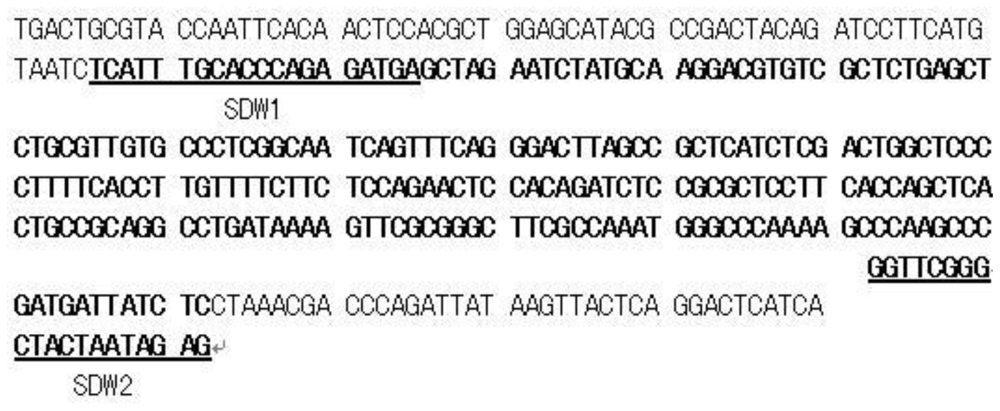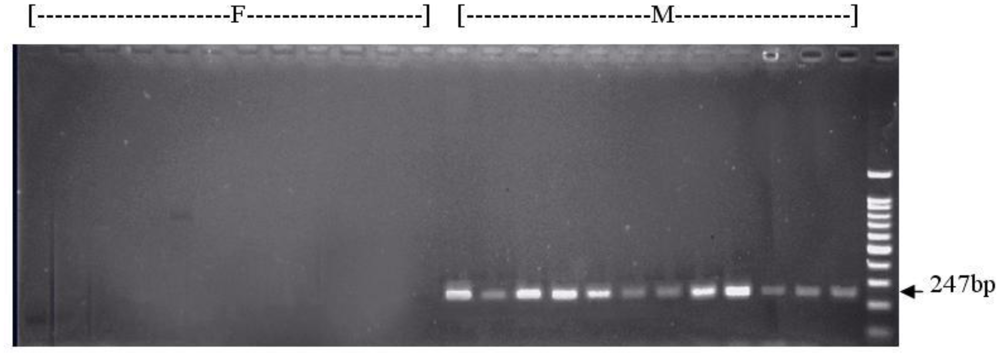Identification of a Male-Specific Amplified Fragment Length Polymorphism (AFLP) and a Sequence Characterized Amplified Region (SCAR) Marker in Eucommia ulmoides Oliv.
Abstract
:1. Introduction
2. Experimental Section
2.1. Plant Material and Genomic DNA Isolation
2.2. AFLP Assay
2.3. AFLP Band Isolation and Sequencing
2.4. Conversion of AFLP Marker into SCAR Marker
3. Results and Discussion
4. Conclusions
Acknowledgements
References
- Xiang, Y; Huang, RH; Liu, XZ; Zhang, Y; Wang, DC. Crystal structure of a novel antigungal protein distinct with five disulfide bridges from Eucommia ulmoides Oliver. At an atomic resolution. J. Struct. Biol 2004, 148, 86–97. [Google Scholar]
- Lee, GW; Yoon, HC; Byun, SY. Inhibitory effect of Eucommia ulmoides Oliver on adipogenic differentiation through proteome analysis. Enzym. Microb. Tech 2004, 35, 632–638. [Google Scholar]
- Kwan, CY; Chen, CX; Deyama, T; Nishibe, S. Endothelium-dependent vasorelaxant effects of the aqueous extracts of the Eucommia ulmoides Oliv. Leaf and bark: Implications on their antihypertensive action. Vasc. Pharmacol 2003, 40, 229–235. [Google Scholar]
- Hsieh, CL; Yen, GC. Antioxidant actions of Du-Zhong (Eucommia ulmoide Oliv.) toward oxidative damage in biomolecules. Life Sci 2000, 66, 1387–1400. [Google Scholar]
- Yen, GC; Hsieh, CL. Inhibitory effects of Du-zhong (Eucommia ulmoides Oliv.) against low-density lipoprotein oxidative modification. Food Chem 2002, 77, 449–456. [Google Scholar]
- Kawasaki, T; Uezono, K; Nakazawa, Y. Antihypertensive mechanism of food for specified health use: “Eucommia leaf glycoside” and its clinical application. J. Health Sci 2000, 22, 29–36. [Google Scholar]
- Nakazawa, Y. Functional and healthy properties of Du-zhong tea and their utilization. Food Ind 1997, 40, 6–15. [Google Scholar]
- Nakamura, T; Odagiri, N; Imai, R; Yoshii, T; Tagashira, E; Nakata, C; Asaumi, S; Onizuka, S; Yahara, M; Nohara, N. Effect of Eucommia leaf (Eucommia ulmoides oliver Leaf; Du-zhong tea) extract on blood pressure(s). Nat. Med 1997, 51, 392–398. [Google Scholar]
- Tangparkdee, J. Structure and biosynthesis of trans-polyisoprene from Eucommia ulmoides. Phytochemistry 1997, 45, 75–80. [Google Scholar]
- Yan, RF. Eucommia ulmoides gum. In Polymeric Materials Encyclopedia; Salamone, JC, Ed.; CRC Press: Boca Raton, FL USA, 1996. [Google Scholar]
- Zhang, KJ. Study of Eucommia in China; Shaanxi Science and Technology Press: Xi’an, China, 1992. [Google Scholar]
- Zhou, ZX. Eucommia ulmoides of China; Guizhou Science and Technology Press: Guiyang, China, 1993. [Google Scholar]
- Wang, BW; Wang, YQ; Mo, H; Luo, LX; Li, MX; Cui, KM. Comparison of cytology, apical buds and gutta content between staminate and pistillate of Eucommia ulmoides trees. Acta Bot. Sin 1999, 41, 11–15. [Google Scholar]
- Du, HY; Du, LY; Fu, JM; Du, XS; Zhang, XZ. The difference and its pertinence analysis of the Gutta-percha content in organs of Eucommia ulmoides Oliv. J. Cent. South For. Univ 2006, 26, 1–4. [Google Scholar]
- Vos, P; Hoger, R; Blecker, M. AFLP: A new technique for DNA fingerprinting. Nucl. Acids Res 1995, 23, 4407–4414. [Google Scholar]
- Michelmore, RW; Paran, I; Kesseli, RV. Identification of markers linked to disease-resistance genes by bulked segregant analysis: A rapid method to detect markers in specific genomic regions by using segregating populations. Proc. Natl. Acad. Sci. USA 1991, 88, 9828–9832. [Google Scholar]
- Spada, A; Caporali, E; Marziani, G; Portaluppi, P; Restivo, FM; Tassi, F; Falavigna, A. A genetic map of Asparagus officinalis based on integrated RFLP, RAPD and AFLP molecular markers. Theor. Appl. Genet 1998, 97, 1083–1089. [Google Scholar]
- Reamon-Büttner, SM; Jung, C. AFLP-derived STS markers for the identification of sex in Asparagus officinalis L. Theor. Appl. Genet 2000, 100, 432–438. [Google Scholar]
- Terauchi, R; Kahl, G. Mapping of the Dioscorea tokoro genome: AFLP markers linked to sex. Genome 1999, 42, 752–762. [Google Scholar]
- Wang, XM; Song, WQ; Liu, S; Li, XL; Chen, RY. AFLP markers related to sex in a dioecious plant Ginkgo biloba. Acta Sci. Nat. Univ. Nankaiensis (sativa) 2001, 34, 5–9. [Google Scholar]
- Parrish, TL; Koelewijn, HP; van Dijk, PJ. Identification of a male-specific AFLP marker in a functionally dioecious fig, Ficus fulva Reinw. ex Bl. (Moraceae). Sex. Plant. Reprod 2004, 17, 17–22. [Google Scholar]
- Stehlik, I; Blattner, FR. Sex-specific SCAR markers in the dioecious plant Rumex nivalis (Polygonaceae) and implications for the evolution of sex chromosomes. Theor. Appl. Genet 2004, 108, 238–242. [Google Scholar]
- Peil, A; Flachowasky, H; Schumann, E; Weber, WE. Sex-linked AFLP markers indicate a pseudoautosomal region in hemp (Cannabis sativa L.). Theor. Appl. Genet 2003, 107, 102–109. [Google Scholar]
- Ainsworth, C; Lu, J; Winfield, M; Parker, JS. Sex Determination by X Autosome Dosage Rumex acetosa (sorrel). In Sex Determination in Plants; Ainsworth,, CC, Ed.; Bios Scientific Publishers: Oxford UK, 1999; pp. 121–136. [Google Scholar]
- Golan-Goldhirsh, A; Jones, R; Rowland, LJ. AFLP markers for sex determination in an ilex species. Acta Hort 2001, 546, 591–595. [Google Scholar]
- Golan-Goldhirsh, A; Barazani, O; Wang, ZS; Khadka, DK; Saunders, JA; Kostiukovsky, V; Rowland, LJ. Genetic relationships among Mediterranean Pistacia species evaluated by RAPD and AFLP markers. Plant Syst. Evol 2004, 246, 9–18. [Google Scholar]
- Rogers, SO; Bendich, AJ. Extraction of DNA from plant tissue. In Plant Molecular Biology Manual; Kluwer Academic: Publish: Dordrecht, The Netherlands, 1988; pp. 1–10. [Google Scholar]
- Ainsworth, C. Boys and girls come out to play: The molecular biology of dioecious plants. Ann. Bot 2000, 86, 211–221. [Google Scholar]
- Sharma, SK; Knox, MR; Ellis, THN. AFLP analysis of the diversity and phylogeny of Lens and its comparison with RAPD analysis. Theor. Appl. Genet 1996, 93, 751–758. [Google Scholar]
- Russell, JR; Fuller, JD; Macaulay, M; Hatz, BG; Jahoor, A; Powell, W; Waugh, R. Direct comparison of levels of genetic variation among barley accessions detected by RFLPs, AFLPs, SSRs, and RAPDs. Theor. Appl. Genet 1997, 95, 714–722. [Google Scholar]
- Pejic, I; Ajmone, MP; Morgante, M; Kozumplick, V; Castiglioni, P; Taramino, G; Motto, M. Comparative analysis of genetic similarity among maize inbred lines detected by RFLPs, RAPDs, SSRs, and AFLPs. Theor. Appl. Genet 1998, 97, 1248–1255. [Google Scholar]
- Khandka, DK; Tuna, M; Tal, M; Nejidat, A; Golan-Goldhirsh, A. Variability in the pattern of random amplified polymorphic DNA. Electrophoresis 1997, 18, 2852–2856. [Google Scholar]
- Lucchini, V. AFLP: A useful tool for biodiversity conservation and management. C.R. Biol 2003, 326, S43–S48. [Google Scholar]
- Hong, DF; Wan, LL; Liu, PW; Yang, GS; He, QB. AFLP and SCAR markers linked to the suppressor gene (Rf) of a dominant genetic male sterility in rapeseed (Brassica napus L.). Euphytica 2006, 151, 401–409. [Google Scholar]
- Paran, I; Michelmore, RW. Development of reliable PCR-based markers linked to downy mildew resistance genes in lettuce. Theor. Appl. Genet 1993, 85, 985–993. [Google Scholar]



© 2011 by the authors; licensee Molecular Diversity Preservation International, Basel, Switzerland. This article is an open-access article distributed under the terms and conditions of the Creative Commons Attribution license (http://creativecommons.org/licenses/by/3.0/).
Share and Cite
Wang, D.-W.; Li, Y.; Li, Z.-Q. Identification of a Male-Specific Amplified Fragment Length Polymorphism (AFLP) and a Sequence Characterized Amplified Region (SCAR) Marker in Eucommia ulmoides Oliv. Int. J. Mol. Sci. 2011, 12, 857-864. https://doi.org/10.3390/ijms12010857
Wang D-W, Li Y, Li Z-Q. Identification of a Male-Specific Amplified Fragment Length Polymorphism (AFLP) and a Sequence Characterized Amplified Region (SCAR) Marker in Eucommia ulmoides Oliv. International Journal of Molecular Sciences. 2011; 12(1):857-864. https://doi.org/10.3390/ijms12010857
Chicago/Turabian StyleWang, Da-Wei, Yu Li, and Zhou-Qi Li. 2011. "Identification of a Male-Specific Amplified Fragment Length Polymorphism (AFLP) and a Sequence Characterized Amplified Region (SCAR) Marker in Eucommia ulmoides Oliv." International Journal of Molecular Sciences 12, no. 1: 857-864. https://doi.org/10.3390/ijms12010857
APA StyleWang, D.-W., Li, Y., & Li, Z.-Q. (2011). Identification of a Male-Specific Amplified Fragment Length Polymorphism (AFLP) and a Sequence Characterized Amplified Region (SCAR) Marker in Eucommia ulmoides Oliv. International Journal of Molecular Sciences, 12(1), 857-864. https://doi.org/10.3390/ijms12010857



